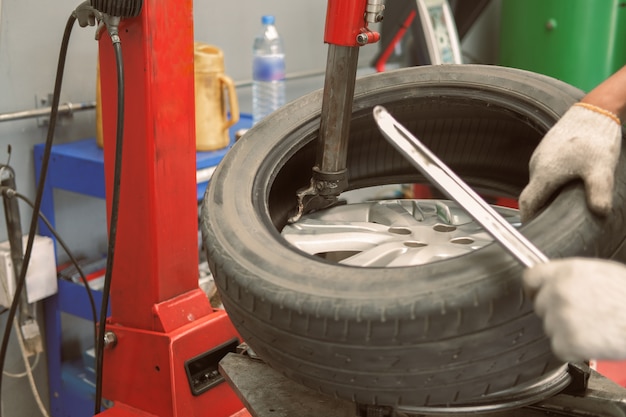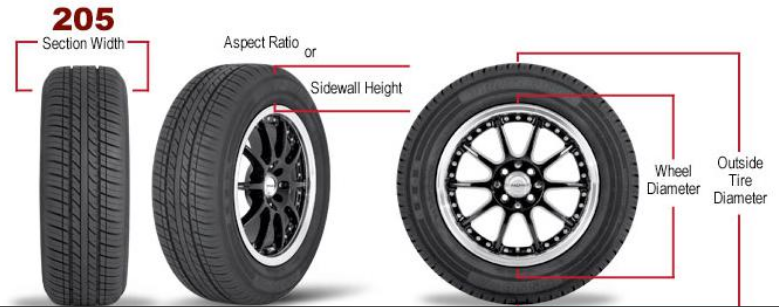Last Updated on April 21, 2024
Unlocking the Secrets of Tire Section Width &
Aspect Ratio for a Smoother Ride
Regarding your vehicle’s tires, there’s more than meets the eye. While you may pay attention to the brand, tread pattern, and size, two essential factors often go overlooked but significantly impact your driving experience: tire section width and sidewall aspect ratio.
In this comprehensive guide, we’ll delve into these crucial aspects of tire design and help you understand how they affect your vehicle’s performance, comfort, and safety. By the end, you’ll be equipped with the knowledge to make informed decisions when it’s time to replace your tires.

Demystifying Tire Section Width
Let’s start with the tire section width. Typically expressed in millimeters, this measurement represents the tire’s width from sidewall to sidewall when mounted on a wheel. For example, if a tire has a section width of 225mm, its widest point is 225 millimeters across.
So, why does tire section width matter? It directly influences the tire’s contact patch—the area of the tire that touches the road surface. A more comprehensive section width generally results in a larger contact patch. A larger contact patch can enhance traction, especially during acceleration and cornering. It provides stability and control, particularly in adverse road conditions like rain or snow.
However, it’s essential to strike a balance. While a more comprehensive section width can improve grip, it may also increase rolling resistance, potentially affecting fuel efficiency. It can also impact ride comfort and noise, as wider tires may transmit more road imperfections and vibrations to the vehicle’s cabin.
Cracking the Code of Sidewall Aspect Ratio
Now, let’s shift our focus to sidewall aspect ratio. This figure is expressed as a percentage and represents the ratio of the tire’s sidewall height to its section width. For example, if a tire has a sidewall aspect ratio of 60, it means the sidewall height is 60% of the tire’s section width.
The sidewall aspect ratio plays a crucial role in ride comfort and handling. Tires with a lower aspect ratio (e.g., 40 or 50) typically have shorter sidewalls. These tires are often associated with sportier, more responsive handling due to reduced sidewall flex during cornering. However, they may sacrifice some ride comfort.
Conversely, tires with a higher aspect ratio (e.g., 70 or 80) have taller sidewalls. These tires provide a smoother and more cushioned ride, making them ideal for comfort-oriented vehicles. They can absorb road irregularities better, resulting in a more comfortable driving experience. However, they may not offer the same level of precise handling as low-profile tires.
Finding the Right Balance
Choosing the right tire section width and sidewall aspect ratio depends on your vehicle type, driving preferences, and the road conditions you encounter. If you prioritize performance and handling, you might opt for wider tires with a lower aspect ratio. Tires with a higher aspect ratio could be your choice for a smoother and more comfortable ride.
Before deciding, consult your vehicle’s manufacturer recommendations, often found in the owner’s manual or the placard inside the driver’s door jamb. These recommendations provide valuable guidance on your vehicle model’s optimal tire size, section width, and aspect ratio.
Tire Easy offers various tires designed to cater to multiple needs and preferences. Whether you’re looking for high-performance tires or those focused on ride comfort, we have you covered. Please browse our selection today and take the first step toward optimizing your vehicle’s performance and comfort.

The first set of numbers on your tire size is the section width. This is the width of the tire in millimeters. The tire section width for passenger vehicles and trucks always ends in a 5 (185, 195, 205, etc.). For motorcycles, it always ends in a zero (110, 130), and in some rare instances, the section width will be in inches instead of millimeters (5, 6, etc). Trailer tires can also be in metric (millimeters) and numeric (inches) sizes.
The aspect ratio is the following number after the section width and slash. This number indicates the tire’s sidewall height from rim to tread. The larger the number, the taller the sidewall; smaller numbers mean a smaller sidewall.
Next, we will examine the tires’ internal construction and speed rating.
Upgrade Your Ride Today
Don’t compromise on your driving experience. Upgrade to the right tires that perfectly balance section width and sidewall aspect ratio. Visit Tire Easy now and explore our extensive collection of tires. Elevate your ride and enjoy a smoother, more responsive journey.
Remember, your tires are your vehicle’s only connection to the road. Make it a connection that ensures both safety and satisfaction. Invest in quality tires from Tire Easy and experience the difference on every drive. Your journey to optimized performance starts here.
Discover the perfect balance of section width and sidewall aspect ratio for your vehicle. Shop Tire Easy for a smoother, safer ride.
FAQs
What is the aspect ratio of a tire sidewall?
The aspect ratio of a tire sidewall is the ratio of the tire’s sidewall height to its section width, expressed as a percentage. It helps determine the tire’s profile and can influence its handling and ride characteristics.
Does the sidewall aspect ratio matter?
Yes, the sidewall aspect ratio matters. It affects the tire’s performance, ride comfort, and handling. Tires with different aspect ratios offer varying levels of responsiveness and comfort, so choosing the correct aspect ratio is essential for your driving needs.
What is the standard aspect ratio for tires?
There isn’t a single “standard” aspect ratio for tires, as it varies depending on the tire’s intended use and design. Common aspect ratios range from 30 to 80, with lower ratios associated with sportier handling and higher ratios with enhanced ride comfort.
Is the tire section width the same as the overall width?
No, the tire section width is not the same as the overall width. Section width refers to the tire’s widest point from sidewall to sidewall when mounted on a wheel. Overall width includes the width of the wheel in addition to the tire’s section width.










